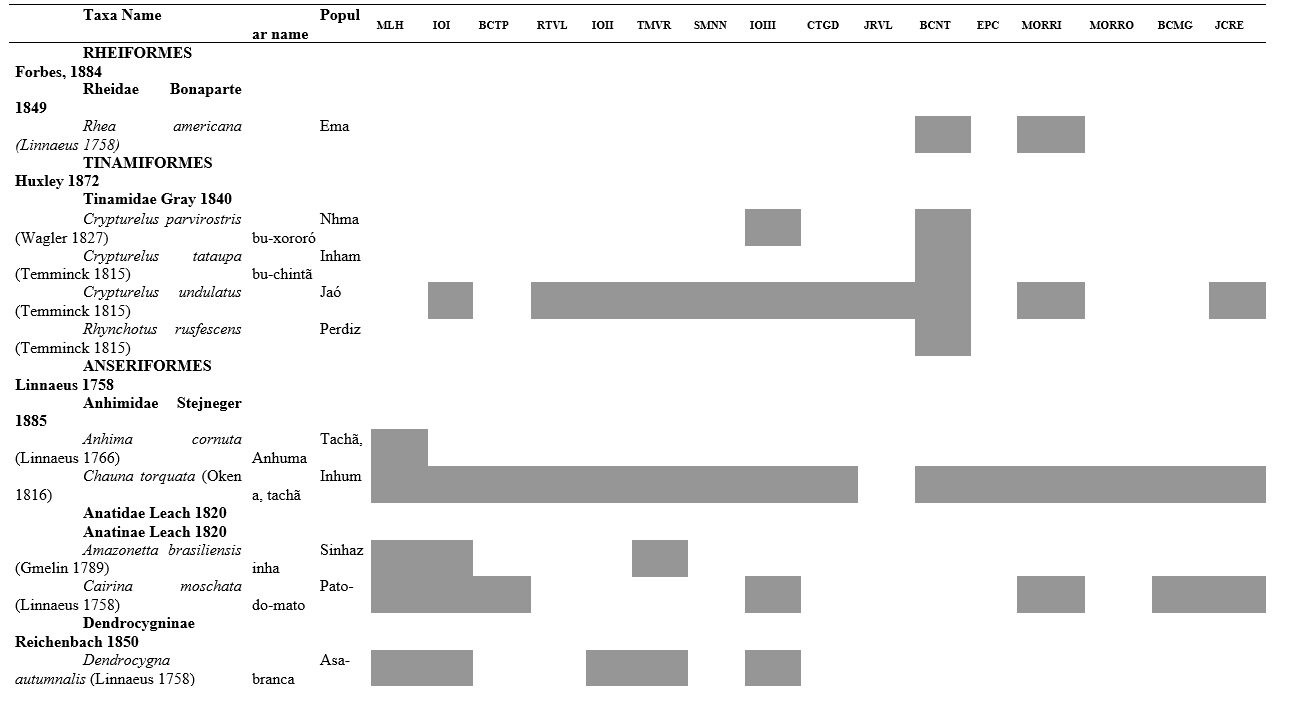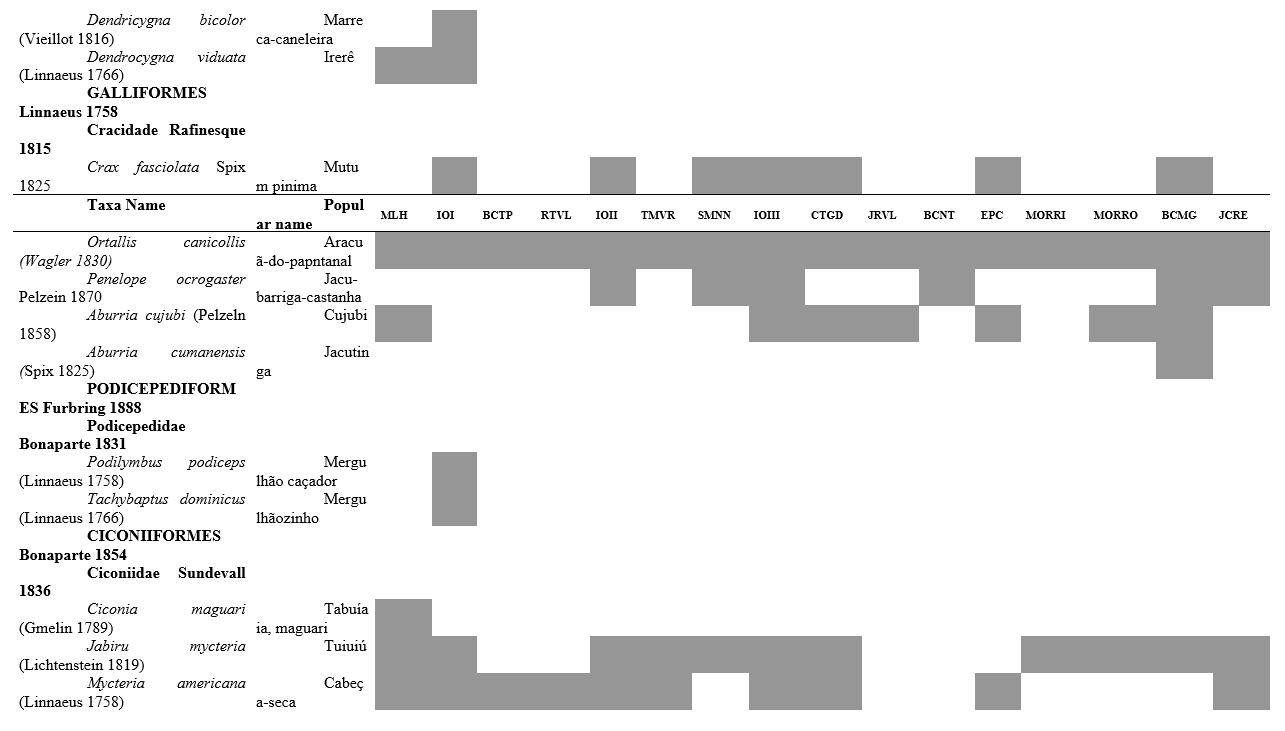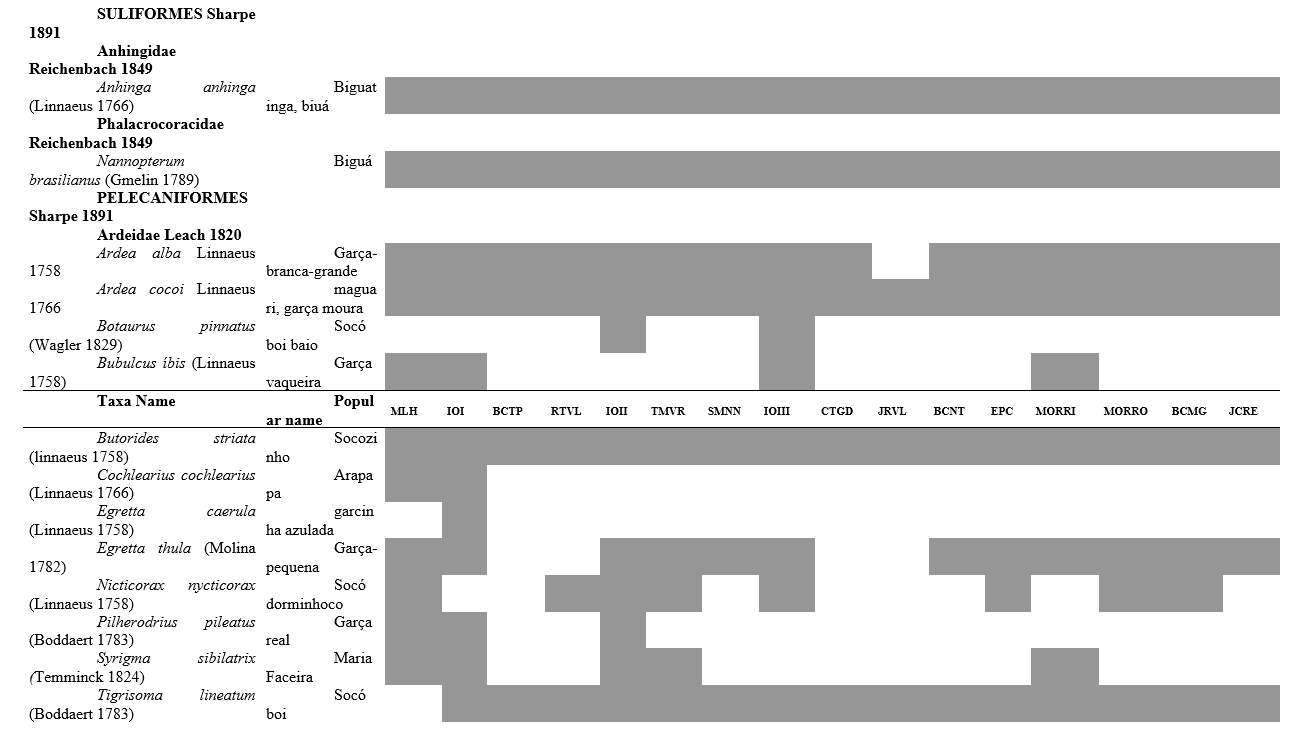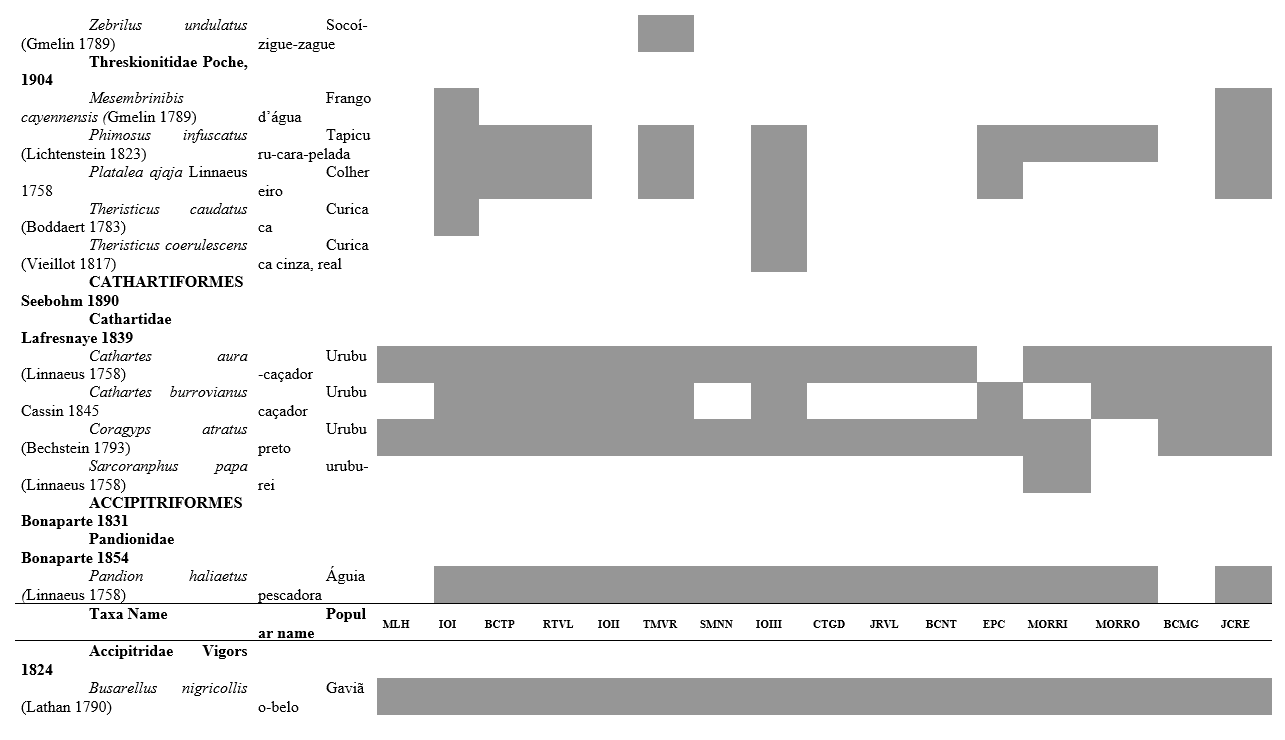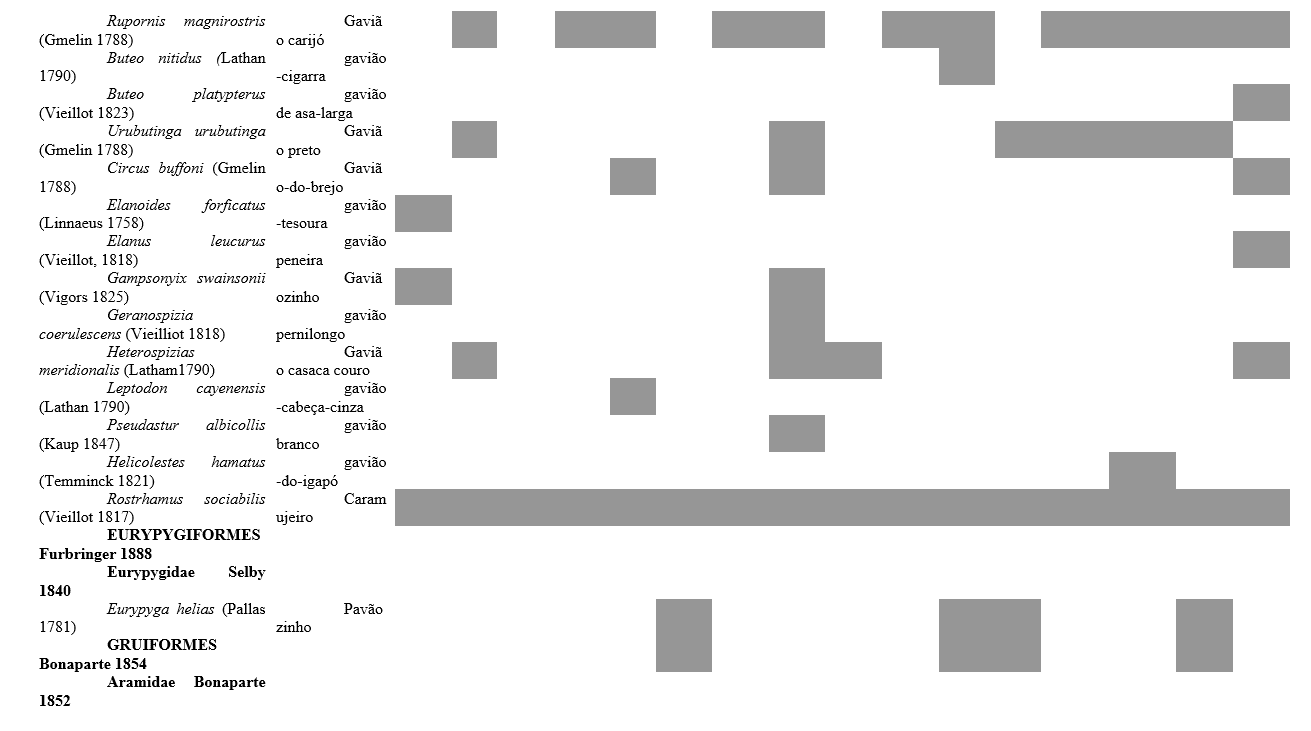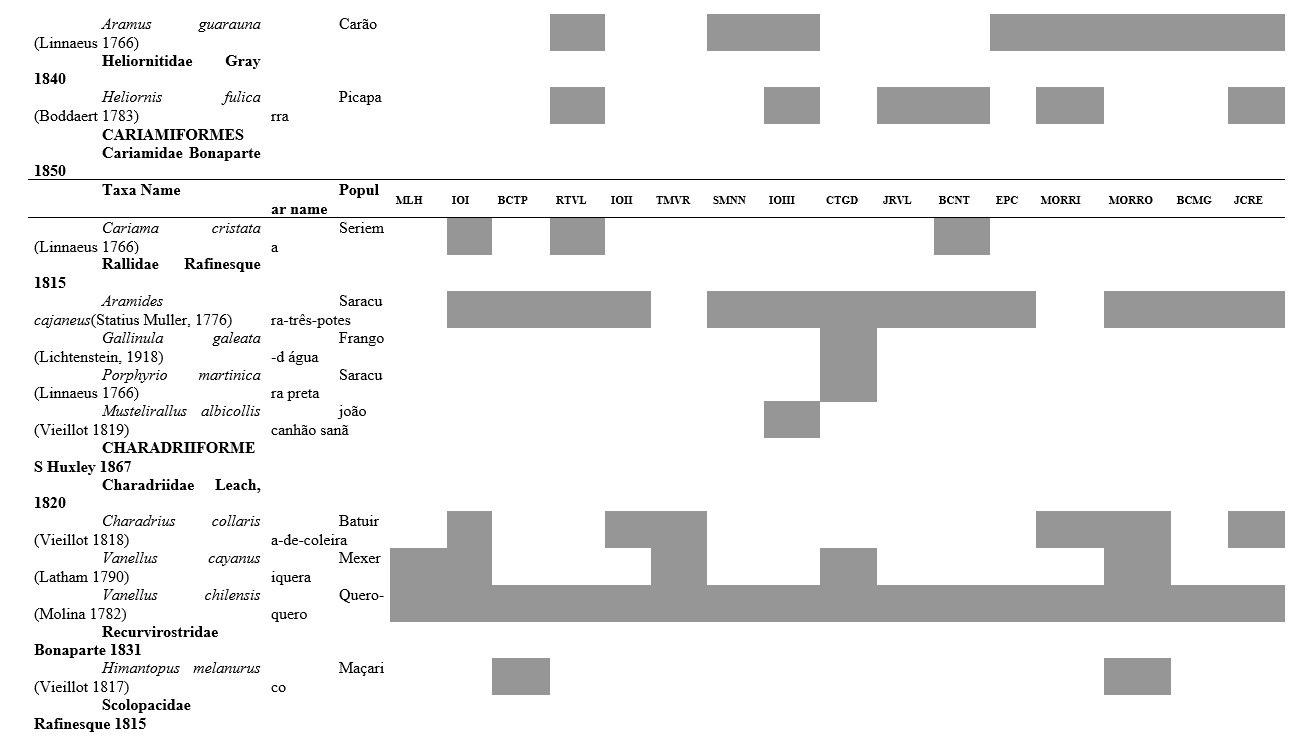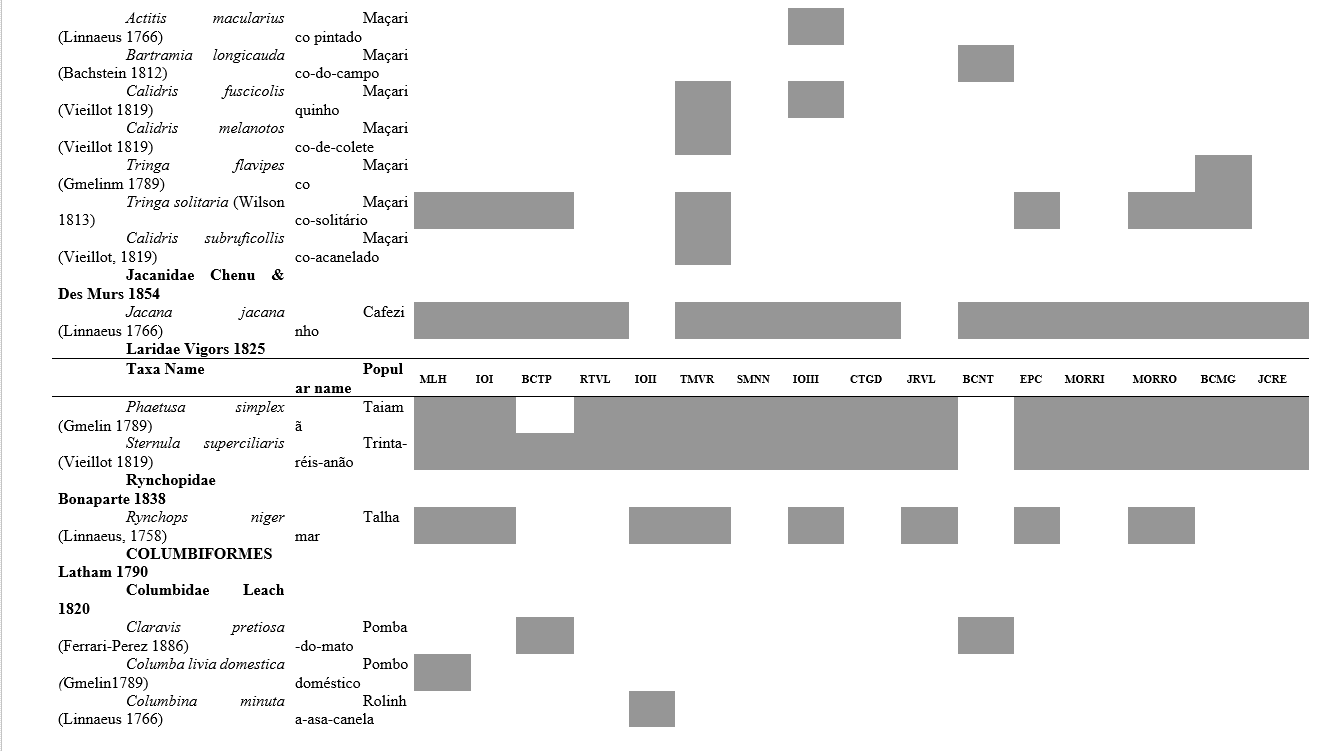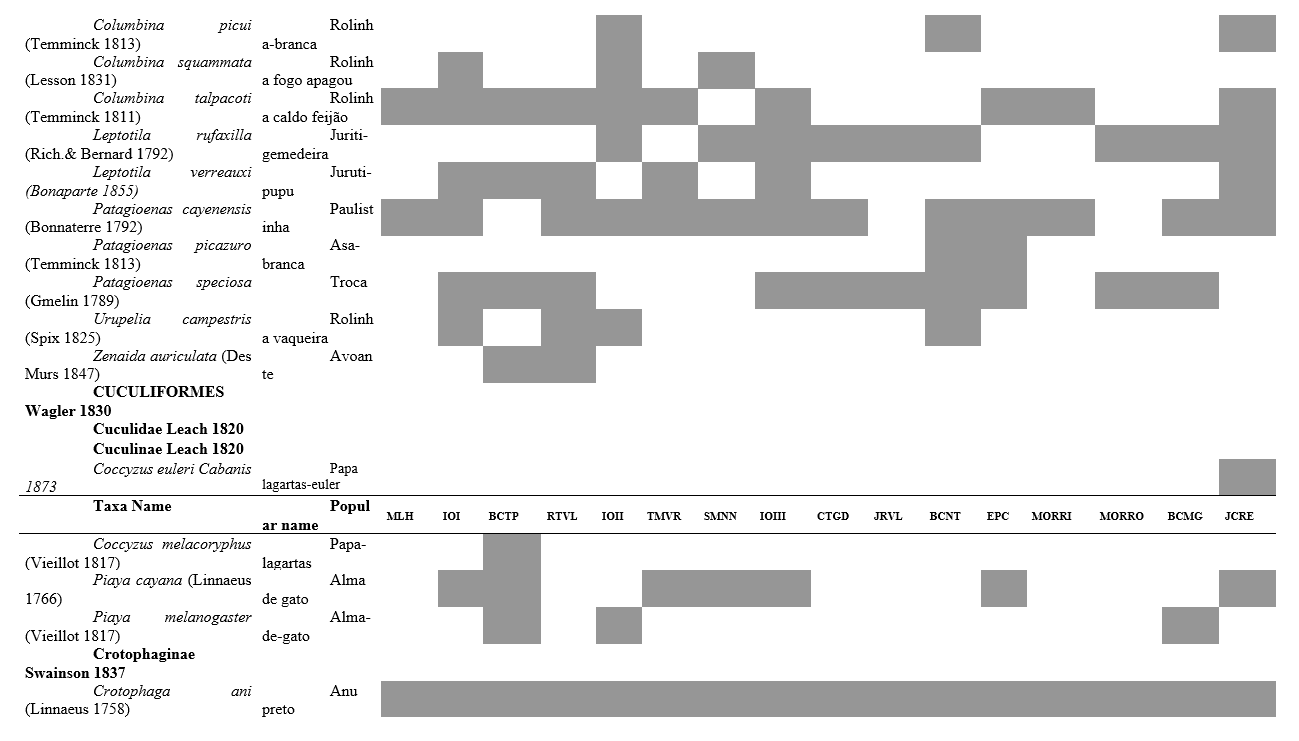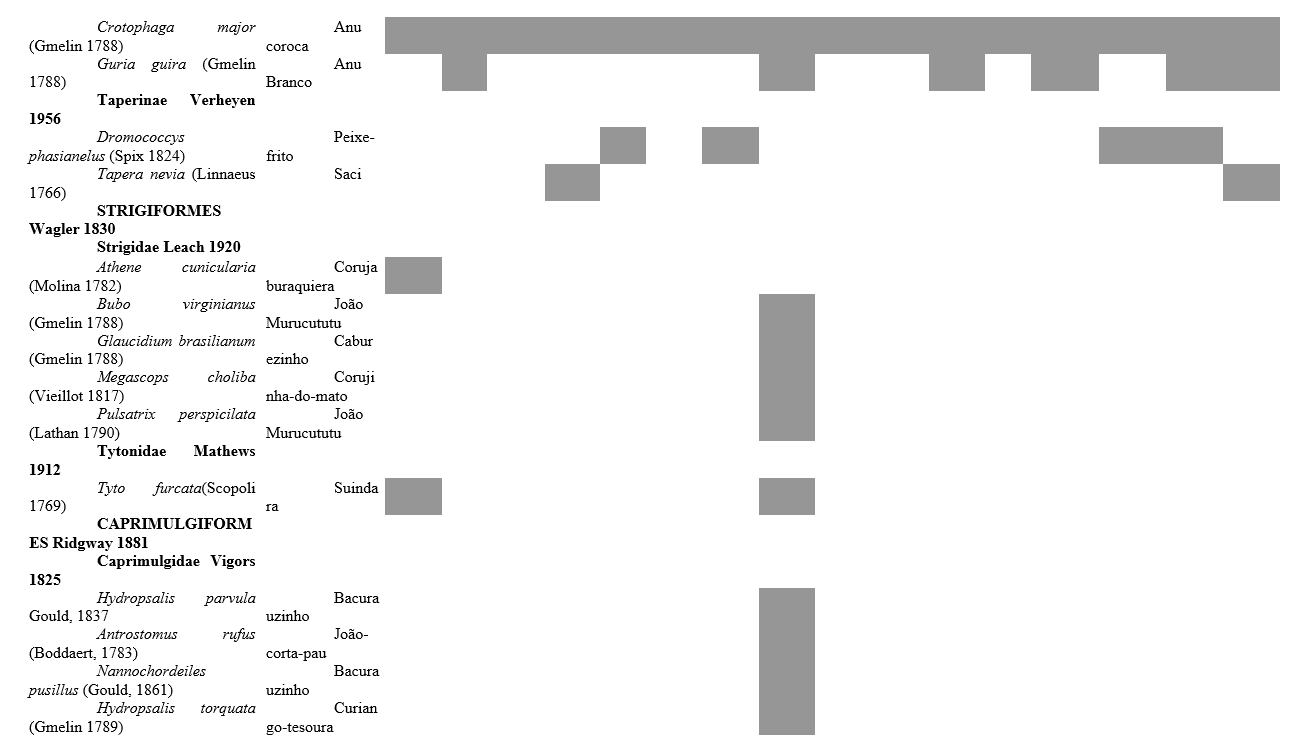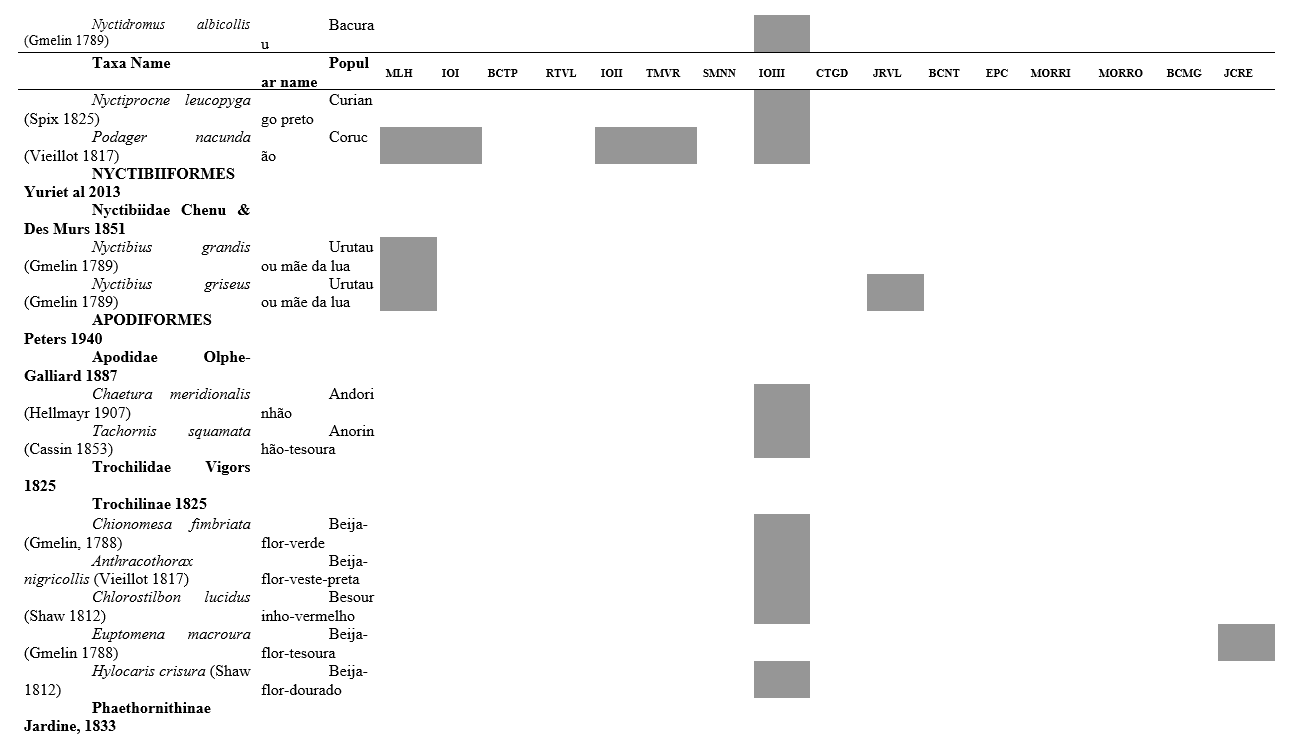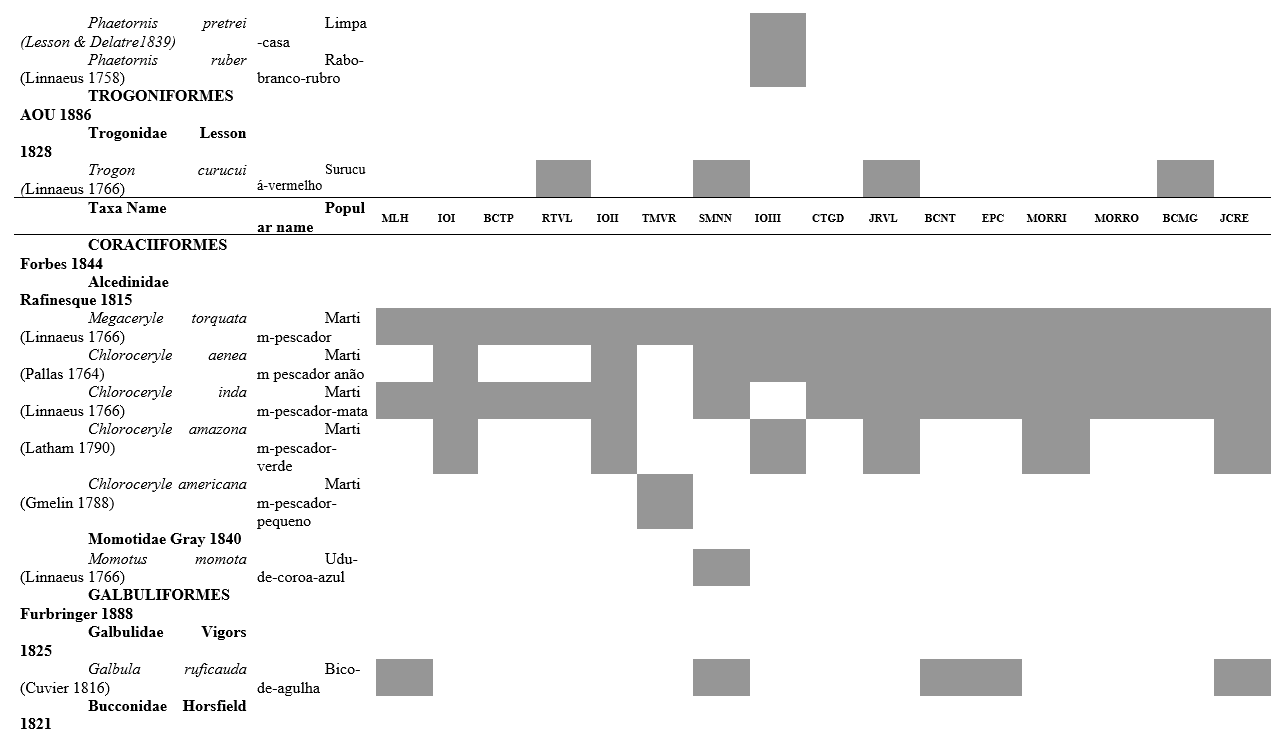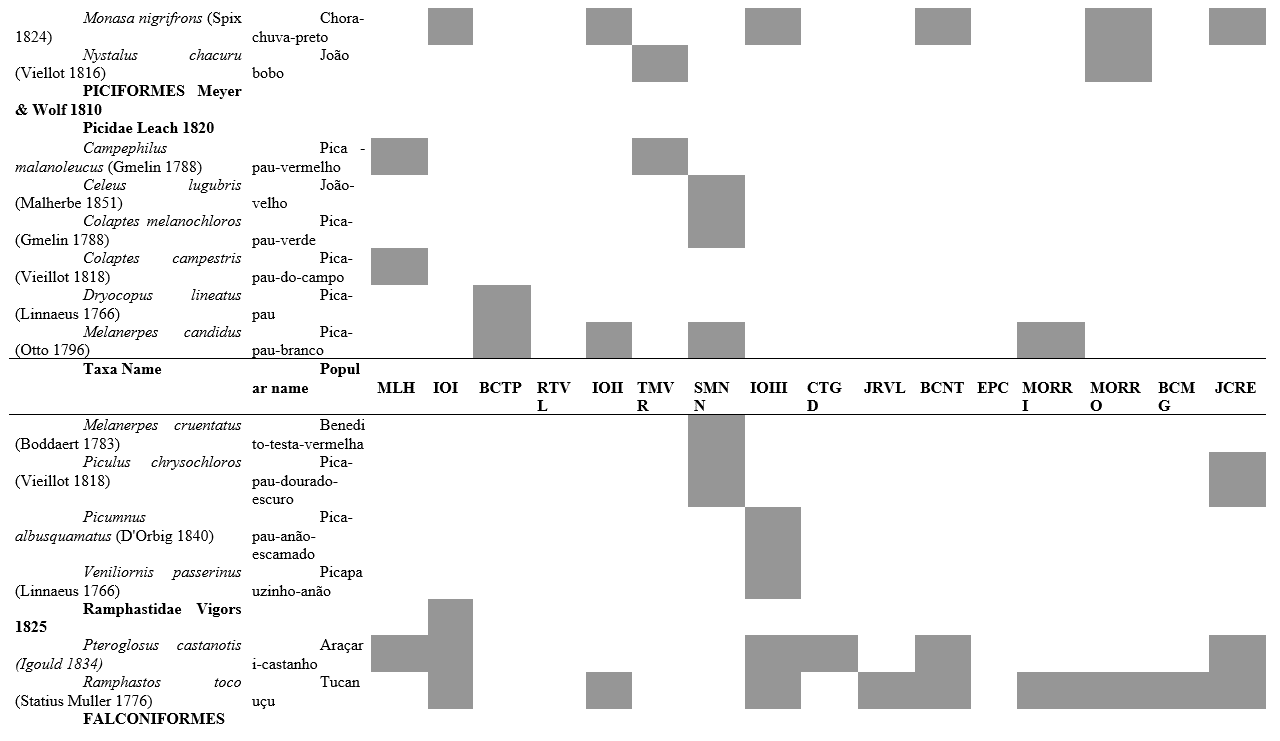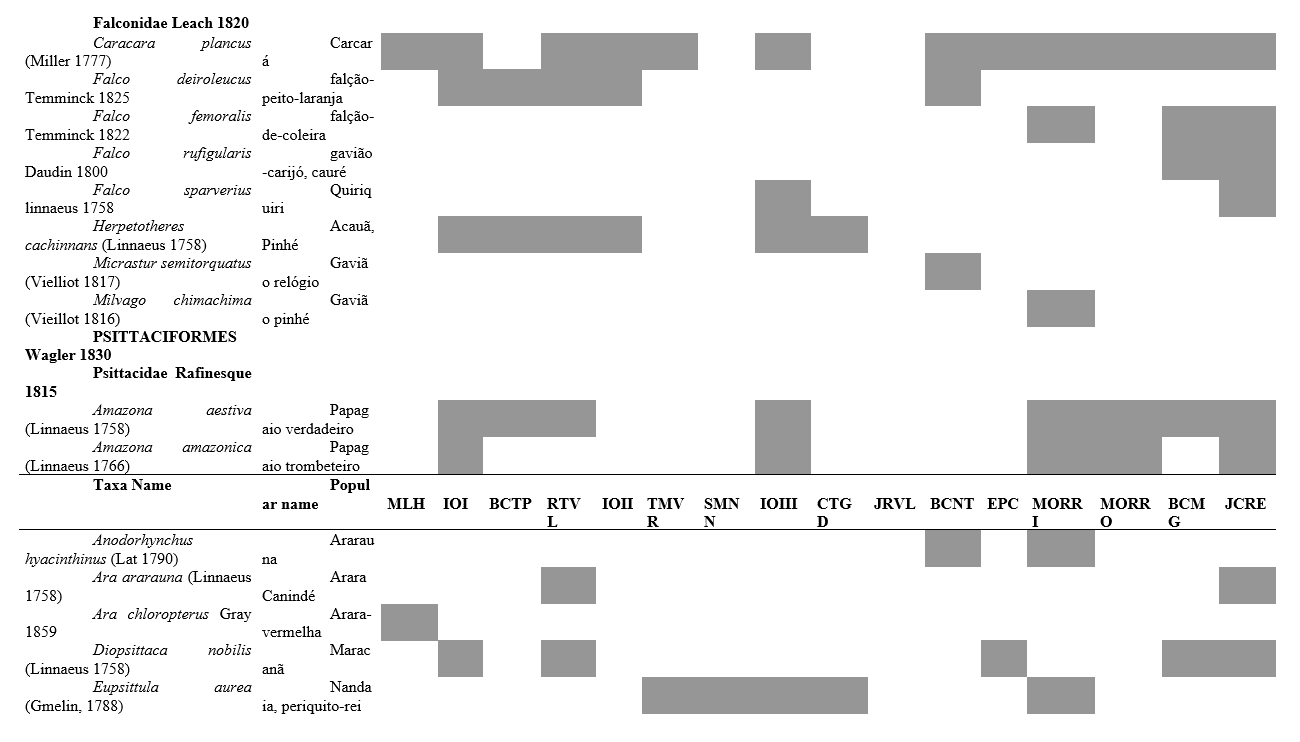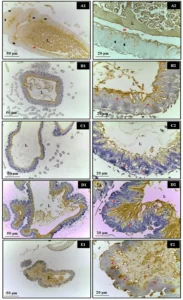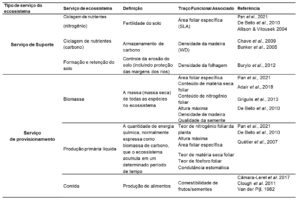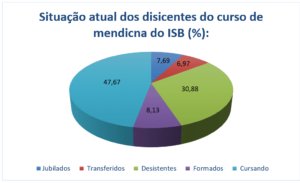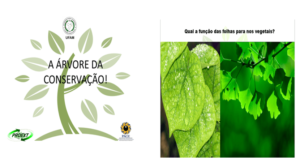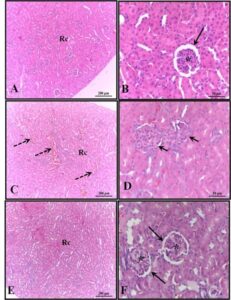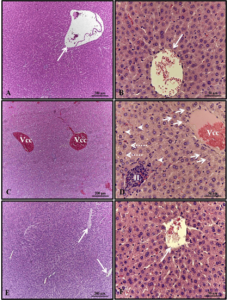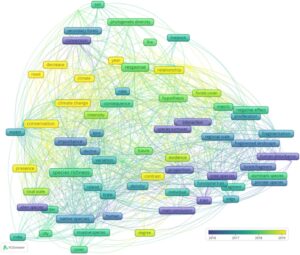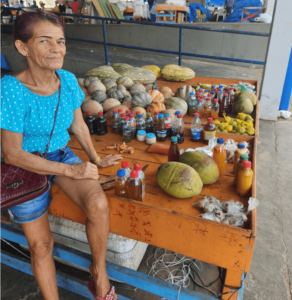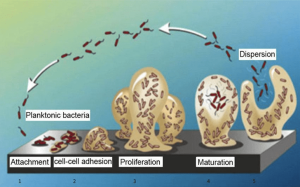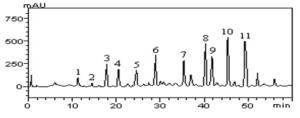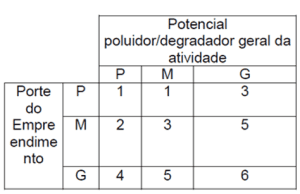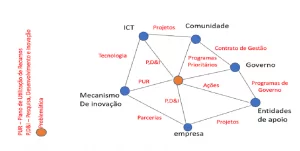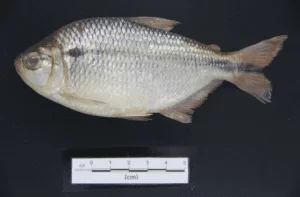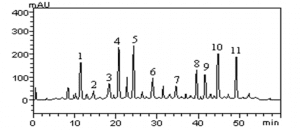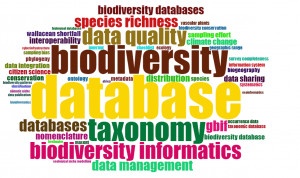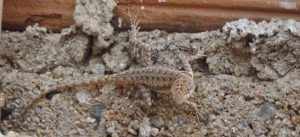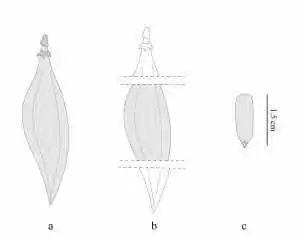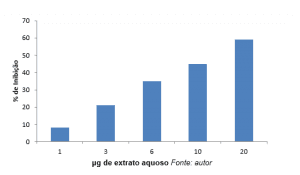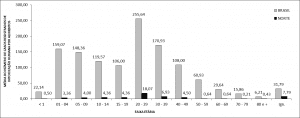ORIGINAL ARTICLE
NUNES, Josué Ribeiro da Silva [1], SILVA, Carolina Joana da [2], DIAS FILHO, Manoel Martins [3]
NUNES, Josué Ribeiro da Silva. SILVA, Carolina Joana da. DIAS FILHO, Manoel Martins. Non-Passeriformes birds species of the Paraguay river, Pantanal wetland, Cáceres – MT Brazil. Revista Científica Multidisciplinar Núcleo do Conhecimento. Year 08, Ed. 02, Vol. 02, pp. 110-133. February 2023. ISSN:2448-0959, Access link in: https://www.nucleodoconhecimento.com.br/biology/birds-species, DOI: 10.32749/nucleodoconhecimento.com.br/biology/birds-species
ABSTRACT
The Pantanal has about 730 bird species, of about 80 are aquatic birds, being the richest and abundant region with aquatic birds of the continent. This study was realized with the aim to register the occurrence and distribution of the birds, over 140 km of the Paraguay river, between the urban area of Caceres-MT county and Descalvados farm, and in 13 parental lakes over the Rivers. The samples were realized by boat with constant speed, all the individuals observed or heard were registered. It was registered in total 177 species of non Passeriformes birds in the Paraguay river and 13 parental lakes. In the excerpt RIOIII of the Paraguay river was registered bigger diversity, between the lake, BJCRE shown bigger richness. It was evidenced the importance of the area by the elevated number of registered species.
Key-words: Birds, Diversity, Lakes, Pantanal.
1. INTRODUCTION
In the context of singularity, conservation and priority, Olson et al. (1998) consider the Pantanal as “with global accent, vulnerable and with high priority for conservation on a regional scale”. The existing data of biological diversity of the Pantanal are small and fragmented yet (NUNES; SILVA and FERRAZ, 2017).
The fragile balance of the Pantanal ecosystem, maintained by the flood pulse (JUNK et al., 1989), are threatened by the new direction of the economic politics. Navigation on the Paraguay River, highways and dam building are the main troubles within of the Pantanal. Before another factor like deforestation (SILVA et al., 2015; SEIDL; SILVA and MORAES, 2001), change on the hydraulic geometry of the rivers, change the natural vegetation on the head waters (SILVA et al., 2000; NUNES et al., 2000)
The Pantanal is the region with high number of aquatic birds in the continent (SICK, 1997). Research estimate about 730 species in the region, including migratory birds, accidental visitors and introduced species, being about 500 species in the region (SILVA et al., 2000; VITORINO et al., 2017; ENDRIGO; PIVATTO and BERNARDON, 2012; STRAUBE e PIVATTO, 2012; NUNES et al., 2020; QUEIROZ et al., 2021).
The purpose of this research is registration the occurrence and distribution of the birds into the different environments of the Paraguay River and parental lakes, between the urban area of the Cáceres city to the Descalvados farm (140 km).
2. MATERIAL AND METHODS
2.1 STUDY AREA
The Pantanal of Mato Grosso state is situated in the western of Brazilian territory, in the Mato Grosso and Mato Grosso do Sul states. Is a depression floodable seasonally, fully contained in the drainage watershed of the Paraguay River and comprises about 140.000 Km2 (BRASIL, 1982) (Figure 1).
The field samples were carried out along the Paraguay River, from the urban area of the Cáceres municipality to the Descalvados farm, traversing 134km of river, between may/2008 to may/2009, trying to sample on al hydrologic periods (Figure1). It was divided into three snippets, being RIO I, characterized like a highly meandric, located between Caceres city to the Canto Grande lake, RIO II shown the most straightened river and more wide, located between Canto Grande lake and Das Éguas/Paca lakes, the snippets RIO III is the transition of straightened to plain and is located between Das Éguas/Paca lakes to Descalvados farm. Surveys were carried out also in 13 parental lakes of the Paraguay River.
The samples collects were realized using boat (25hp, 2t, Yamaha), by medium speed of 15 km/h in the river and lakes. To observation it was used binoculars (7 x 50 mm) and photographic register by means of a digital camera Canon Rebel XTI, with 12 mega pixel. The sample points were marked using GPS, Garmim etrax vista. The nomenclature used followed NBRO (2014).
Figure 1. Study area at the Paraguay river, from Caceres municipality to Descalvados Farm, Caceres – MT. Drowned by Landsat, 2008. SEMA-MT
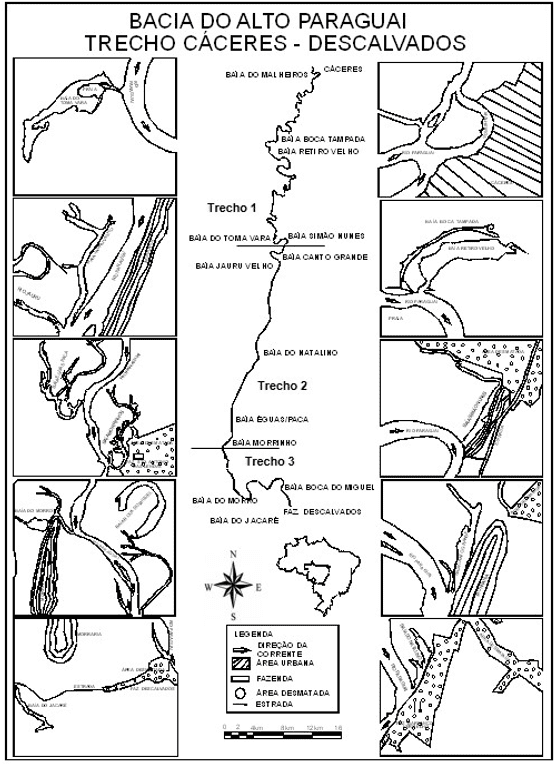
3. RESULTS AND DISCUSSION
During sample collects, it was registered 177 species distributed on 21 orders and 42 families, totalizing 480 hours of observation. This is the first systematic survey in this area.
The figure 2, show new species on each collect, repeated species per collect, species cumulative curve, and the number of species per collect on the study area, evidences the tendency to stabilization. Although is it possible to exists not sampled species in the region, we believe that the survey was satisfactory, because the kind of environment mainly aquatic or riverine not shown a bigger variation.
Figure 2. Species cumulative curve at the Paraguay River, from Caceres municipality to Descalvados farm, Pantanal of Caceres – MT
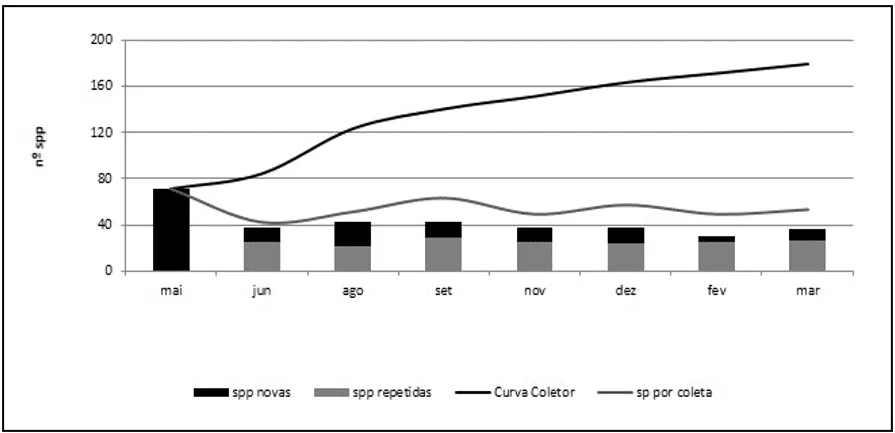
Nunes; Tomas and Ticianeli (2005), studing the Nhumirin farm on the Pantanal of Nhecolandia, identify 272 species including passeriformes and non passeriformes. Tubelis and Tomas (2003) published a list with 465 species of passeriformes and non passeriformes for the Pantanal and surrounding area, Pessoa et al. (2013) found 169 especies estudying passeriformes and non passeriformes in the Paragay river in the Barra do Bugres municipallity.
In the PCBAP (BRASIL, 1997) it were identified 656 bird species on the Pantanal matogrossense for the states of Mato Grosso and Mato Grosso do Sul, being that it was visited ten localities, for theses authors the number of bird species can reach 700.
Of the 21 orders found, Falconiformes showed 24 species being that the total of the species for this order in Brazil is of 69. In this research it was found 35% of this amount, Nunes; Tomas and Ticianeli (2005), Nunes; Silva and Dias Filho (2012a), Nunes et al. (2020a; 2020b), Fieker et al. (2013) e Farias et al. (2015) found the same standard, studying the Pantanal of Mato Grosso do Sul and the same area and Nunes et al. (2018) studding the wetlands of Guaporé River.
For the Ciconiiformes it was identified 21 species. The Brazil had 36 species of this order, being that for the Pantanal region, it was found 66% of this amount, because the biggest part of the species of this order, are aquatic bird, and this is the main environment in the region, allowing that those species to be very common in the Pantanal.
The Psitaciformes showed 16 species, being that the total number for Brazil is of 84, so in this study it was observed 18% of these species. Columbiformes was the fourth order in number of species (13), being that, the total for Brazil is 22 species, reaching 60% on this research.
The orders who shown the small number of bird species were, Struthioniformes with one specie, Pelecaniformes with two species. Podicepediformes showed two species. Trogoniformes two species and Galbuliformes three species.
We registered the following orders Psittaciformes, Pelecaniformes, Ciconiiformes, Cathartiiformes, Coraciiformes, Columbiformes, Galliformes, Cuculiformes and Falconiformes in all sample points.
The most representative families were Psittacidae with 16 species, totalizing 18% of the total, which reach 84 species. Accipitridae with 15 species totalize 34% of the total of species of this family, which in Brazil is about 45 species. It were found 14 species belonging to the Ardeidae family, in the Brazil the number os species belonging to this family is of 21 species, being that the species found in this study, make up 67% of this total.
The families Psittacidae, Phalacrocoracidae, Anhingidae, Ardeidae, Cathartidae, Alcedinidae, Columbidae, Cracidae and Accipitridae were observed on all samples points.
The table 2 shown a list of species as well as their distribution per sample unit, though the presence absence of the individulas into the localities, totalizing 177 species, distributed unto the 16 samples points, along Paraguay River to Descalvados farm.
The major influence in the bird fauna in the Pantanal is certainly the Cerrado biome, being this contributes with the biggest part of the species found, this due to the occurrence of a typical vegetation of Cerrado into the Pantanal. Another factor that favors the presence of species from Cerrado, including the endemics one, is the low endemism in the Pantanal (FROTA et al., 2020a; FROTA et al., 2000b; VITORINO et al., 2018; NUNES; SILVEIRA and SILVA, 2012; NUNES and TOMAS, 2004).
Table 1. Registered species on all sample points along of Paraguay River and the parental lakes
Source: authors.Legend: BMLH: Lake Malheiros; RIOI: Paraguay River I; BBCTP: Lake Boca Tampada; BRTVL: Lake Retiro Velho; RIOII: Paraguay River II; BTMVR: Lake Toma Vara; BSMNN: Lake Simão Nunes; RIOIII: Paraguay River III; BCTGD: Lake Canto Grande; BJRVL: Lake Jauru Velho; BBCNT: Lake Natalino; BEPC: Lake Éguas/Paca; BMORRI: Lake Morrinhos; BMORRO: Lake Morro; BBCMG: Lake Miguel; BJCRE: Lake Jacaré.
4. CONCLUSION
The biggest richness were observed on the plain region, also for river and lakes, followed by meandric river and in the streight part was registered the small number of species, before it was big when compared with other regions of Mato Grosso.
The study area are very important for the bird conservation, because of its diversity of habitats for birds species and not only because of the number of registered species but also for the amount of each.
The area is important for the bird conservation, and for tourism, mainly birdwatching, due to “ninhal” nursery presence, this area need more attention from the local people and government.
The number of species identified proves the importance of the place for the birds life.
ACKNOWLEDGMENTS
I thank everyone who directly and indirectly assisted in this research, to FAPEMAT, Research Support Fund of the state of Mato Grosso for financial support with the financing of the project “Avifauna do Rio Paraguai, Pantanal de Cáceres – MT”.
REFERENCES
BRASIL. Ministério das Minas e Energia. Projeto RadamBrasil: levantamento de recursos naturais: SD.21 Cuiabá. Rio de Janeiro: DNPM/Projeto RadamBrasil; MME/SG/Projeto RadamBrasil, 1982.
BRASIL. Programa Nacional do Meio Ambiente. Plano de Conservação da Bacia do Alto Paraguai (Pantanal): diagnóstico dos meios físico e biótico: meio biótico. Brasília: O Programa, 1997.
ENDRIGO, E.; PIVATTO, M. A. C., BERNARDON, G. Aves do Pantanal: guia fotográfico. São Paulo: Aves e Fotos, 2012.
FARIAS, T. N. et al. Avifauna associada a área de preservação permanente urbana de Tangará da Serra – MT. Enciclopédia Biosfera, v.11, n.22, p.2945, 2015.
FROTA, A. V. B. et al. Birds of the Ramsar site Estação Ecológica de Taiama and buffer zone, Pantanal wetlands, Brazil. Check List, v.16, n.2, p.401-422, 2020a. DOI: 10.15560/16.2.401.
FROTA, A. V. B. et al. Bird community structure in macrohabitats of the aquaticterrestrial transition zone in the Pantanal Wetland, Brazil. Oecologia Australis, v. 24, n. 3, p. 615-634, 2020b. DOI://doi.org/10.4257/oeco.2020.2403.07.
JUNK, W. F.; BAYLEY, P. B.; SPARKS, R. E. The flood pulse concept in river floodplains. Canadian Special Publication of Fisheries and Aquatic Sciences, v. 106, n. 1, p. 110-127, 1989.
NUNES A. P.; TOMAS, W. M. Análise preliminar das relações biogeográficas da avifauna do Pantanal com biomas adjacentes. In: Anais do IV simpósio sobre recursos naturais e sócio econômicos do Pantanal Corumbá, 2004.
NUNES, A. P.; TOMAS, W. M.; TICIANELI, F. A. T. Aves da Fazenda Nhumirim, Pantanal de Nhecolândia, M. S. Corumbá: Embrapa Pantanal, 2005.
NUNES, J. R. S. et al. Distribuição de frequência de habitats por aves aquáticas piscívoras do Lago Camaleão, Ilha da Marchantaria, AM. In: ZUANON, J.; VENTICINE, E. Ecologia da Floresta Amazônica: curso de campo. Manaus: Editora INPA, 2000.
NUNES, J. R. S. et al. Limnologia e biodiversidade aquática na fronteira Brasil – Bolívia. In: SILVA, C. J. da et al. ABC do Guaporé. Cuiabá: Unemat; Cárceres: Entrelinhas, 2018.
NUNES, J. R. da S. et al. Mudança na composição de assembleia de aves aquáticas associadas com mudanças no nível de água em uma zona de transição terrestre aquática no Pantanal de Mato Grosso, Brasil. Research, Society and Development, v. 9, n.10, p. e4479108555, 2020a. DOI: https://doi.org/10.33448/rsd-v9i10.8555.
NUNES, J. R. da S. et al. Bases sócio ambientais para o ecoturismo do sítio Ramsar Parque Nacional do Pantanal associado a comunidades tradicionais do seu entorno. In: SILVA, C. J.; GUARIM NETO, G. Comunidades tradicionais do Pantanal. Cuiabá: Unemat; Cárceres: Entrelinhas, 2020b.
NUNES, J. R. S.; SILVA, C. J. da; DIAS FILHO, M. M. Ocorrência e abundância de Falconiformes no rio Paraguai, Pantanal de Cáceres, MT, Brasil. In: SANTOS, J. E.; SILVA, C. J. da; MOSCHINI, L. E. Paisagem, biodiversidade e cultura. São Carlos: Rima Editora, 2012, p.353-374.
NUNES, J. R. S.; SILVA; C. J. da; FERRAZ, L. Mato Grosso e seus biomas: biodiversidade, desafios socioambientais, unidades de conservação, iniciativas de políticas públicas e privadas para a conservação. Revista Gestão Universitária, v. 07, 2017.
NUNES, J. R. S.; SILVEIRA, R. A.; SILVA, C. J. da. Avifauna do Rio Cuiabá e do Sistema de Baías Chacororé – Sinhá Mariana. In: Silva, C. J. da; SIMONI, J. Água, biodiversdiade e cultura do Pantanal. Cuiabá: Carlini e Caniato Editorial; Editora Unemat, 2012.
OLSON, D. et al. Freshwater Biodiversity of Latin America and the Caribbean: conservation assessement. Biodiversity Support Program, p.70, 1998.
PESSOA, S.P. et al. A influência da cobertura vegetal na distribuição e composição da avifauna na interbacia do rio Paraguai médio, Mato Grosso, Brasil. Enciclopédia Biosfera, v.10, n.18, p.14. 2013.
QUEIROZ, R. F. N. de et al. Changes in the structure of bird communities over 10 years in the Ecological Corridor of Paraguay River, Pantanal wetland. Revista Ibero Americana de Ciências Ambientais, v.12, n.3, p.111-125, 2021. DOI: http://doi.org/10.6008/CBPC2179-6858.2021.003.0011.
SICK, H. Ornitologia Brasileira. Nova Fronteira: Rio de Janeiro, 1997.
SILVA, C. J. et al. Biodiversity and its drivers and pressures of change in the wetlands of the Upper Paraguay-Guapore Ecotone, MatoGrosso (Brazil). Land Use Policy, v. 47, p. 163–178, 2015. DOI: 10.1016/j.landusepol.2015.04.004
SILVA, C. J. Ecological basis for the management of the Pantanal – Upper Paraguay River Basin. In: SMITS, A. J. M.; NIENHUIS, P.; LEUVEN, R.S.E.W. New Approaches to River Management. Leiden: Backhuys, 2000, p. 97-117.
SEIDL, A. F.; SILVA, J.S.V.; MORAES, A.S. Cattle ranching and deforestation in the Brazilian Pantanal. Ecological economics, v. 36, n. 3, p. 413-425, 2001.
STRAUBE, F.C.; PIVATTO, M. A. C. O Pantanal do Mato Grosso do Sul: destino para a observação de aves. Atualidades Ornitológicas On-line, n. 167, p. 33-50, 2012.
TUBELIS, D. P.; TOMAS, W. M. Birds species of the Pantanal wetland, Brazil. Ararajuba, v.11, n.1, p. 5-37, 2003.
VITORINO, B. D. et al. Avifauna associada a duas áreas de nascentes no Assentamento Laranjeiras I, Província Serrana, Cáceres – Mato Grosso. In: CASTRILLON, S. K. I.; PUHL, J. I.; LEÃO, D. da S. Águas escassas no Pantanal: recuperação das nascentes e fragmentos de mata ciliar do córrego no Assentamento Laranjeira I e mobilização para conservação dos recursos hídricos no Pantanal mato-grossense. Cuiabá: Carlini & Caniato Editorial, 2017.
VITORINO, B. D. et al. Birds of Estação Ecológica da Serra das Araras, state of Mato Grosso, Brazil: additions and review. Check List, v.14, n. 5, p.893-922, 2018. DOI: https://doi.org/10.15560/14.5.893.
[1] Doctor. ORCID: 0000-0003-3927-5063. LATTES CURRICULUM: http://lattes.cnpq.br/3292016056510295.
[2] Doctor. ORCID: 0000-0003-0517-1661. LATTES CURRICULUM: http://lattes.cnpq.br/5253872582067659.
[3] Doctor. ORCID: 0000-0003-0726-7069. LATTES CURRICULUM: http://lattes.cnpq.br/1346547036069954.
Sent: January, 2023.
Approved: February, 2023.
